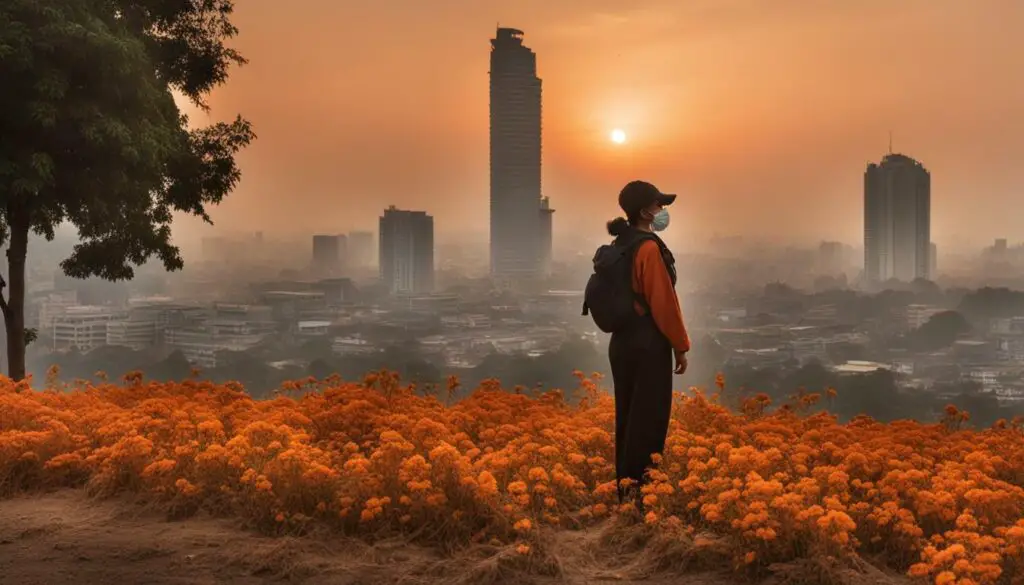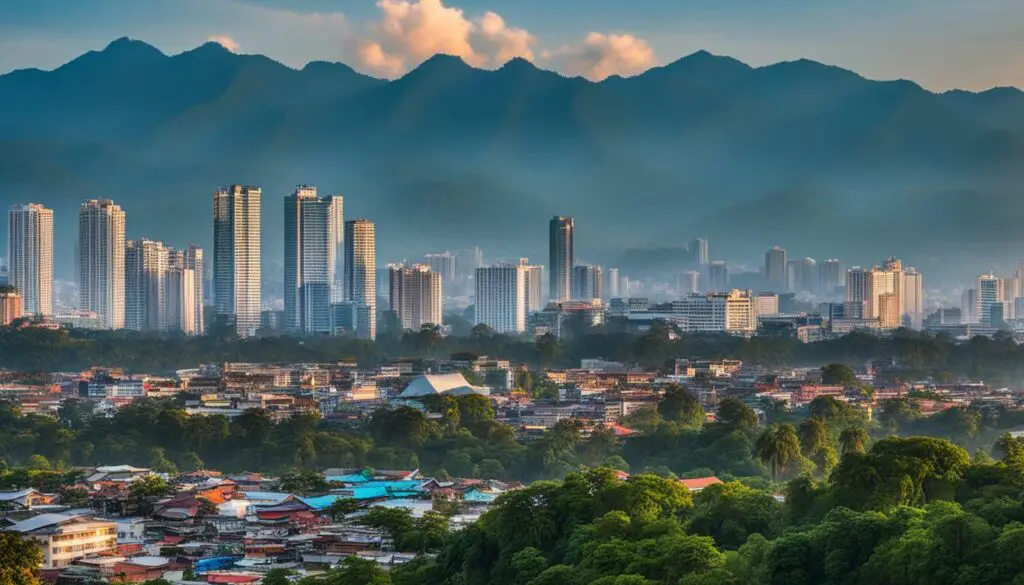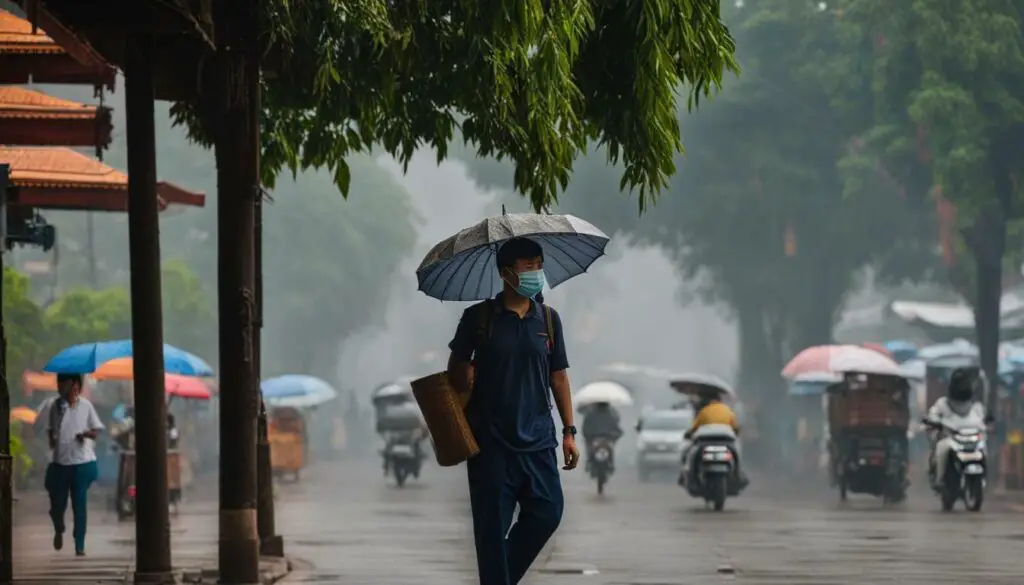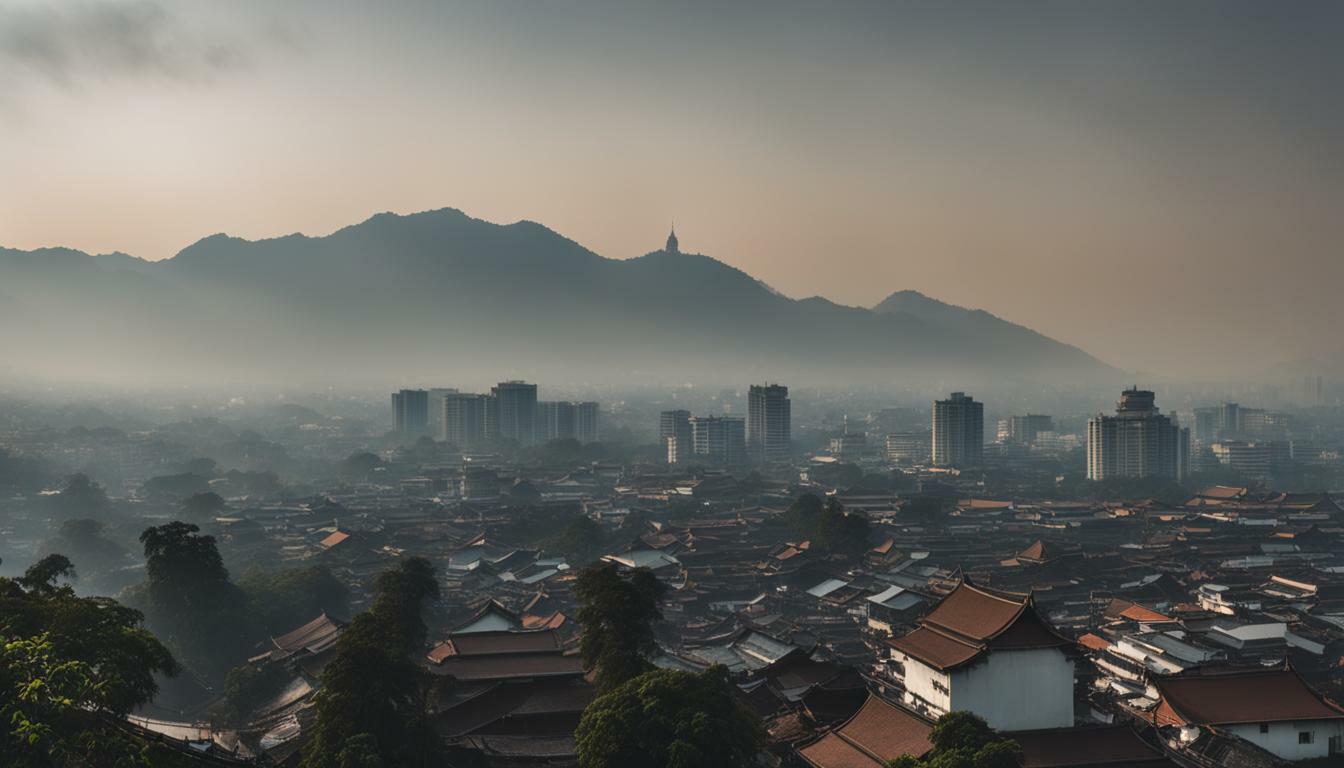Chiang Mai, a popular tourist destination in Northern Thailand, is known for its scenic beauty, rich culture, and vibrant nightlife. However, the city is also notorious for its poor air quality, which can have serious health consequences for both locals and visitors. The high levels of air pollution are mainly caused by human-made factors, such as vehicular emissions, agricultural burning, and industrial activities, as well as natural factors like dust particles and weather patterns.
It is essential to understand the factors impacting air quality in Chiang Mai and how to protect oneself from pollution. This guide provides valuable insights into the air quality index (AQI), respiratory health, air quality monitors, dust particles, smog, and government initiatives and policies to improve air quality.
- Chiang Mai is known for its poor air quality, caused by both human-made and natural factors.
- Understanding the AQI, respiratory health, air quality monitors, dust particles, and smog is crucial for protecting oneself from pollution.
- The government has taken several initiatives and implemented policies to improve air quality.
- Community involvement and awareness are essential in promoting sustainable practices and advocating for cleaner air in Chiang Mai.
- Collective efforts are required to achieve and maintain clean and healthy air in Chiang Mai.
Factors Affecting Air Quality in Chiang Mai
Air quality in Chiang Mai is affected by various factors, both natural and human-made. These factors can contribute to high levels of air pollution, which can have serious health consequences. Understanding these factors is essential for addressing air quality issues and promoting clean air for the residents of Chiang Mai.
Natural Factors
Natural factors that affect air quality in Chiang Mai include weather patterns and geography. The city is located in a valley surrounded by mountains, which can trap pollutants and prevent them from dispersing. In addition, certain weather patterns, such as temperature inversions, can exacerbate pollution levels by trapping emissions close to the ground.
Human-Made Factors
Human-made factors are major contributors to air pollution in Chiang Mai. One of the most significant sources of pollution is vehicular emissions. With increasing traffic congestion in the city, the number of vehicles on the roads has grown, resulting in higher levels of pollutants in the air. Industrial activities, such as factories and power plants, also contribute to air pollution in Chiang Mai. Agricultural practices, such as burning of crops and forest fires, are additional sources of pollution.

Other human-made factors that affect air quality in Chiang Mai include household pollutants and waste burning. Many households use wood-burning stoves for cooking and heating, which can release harmful particulate matter into the air. Also, waste burning in open areas can release pollutants into the atmosphere. These human-made factors can have a severe impact on air quality in Chiang Mai, leading to serious health consequences for residents.
It is essential to address these factors that affect air quality in Chiang Mai to improve the overall health and well-being of its residents. Government agencies, environmental organizations, and citizens must work together to reduce emissions, promote sustainable practices, and raise awareness of the importance of clean air.
Measuring Air Quality: The Air Quality Index (AQI)
The Air Quality Index (AQI) is a tool used to measure and report the levels of air pollution in Chiang Mai. It takes into account several air pollutants, such as particulate matter, carbon monoxide, sulfur dioxide, and nitrogen dioxide, and converts the measurements into a single score. The AQI is divided into categories that range from good to hazardous, with each level indicating the potential health risks associated with the pollution levels.
The AQI is calculated based on hourly or daily averages of the pollutant levels measured by air quality monitoring stations. The stations are located throughout the city and provide real-time data on the air quality levels. The information is then used by government agencies, environmental organizations, and the public to make informed decisions about their activities and potential exposure to air pollution.

Understanding the AQI can help individuals take measures to protect themselves from the harmful effects of poor air quality. For instance, on days when the AQI is in the unhealthy range, it is recommended to reduce outdoor activities, wear masks that provide filtration, and use air purifiers indoors. By checking the AQI regularly, residents can stay informed about the air quality levels in Chiang Mai and take steps to minimize their exposure to pollution.
Health Impacts of Poor Air Quality
Poor air quality in Chiang Mai can have significant impacts on respiratory health. Long-term exposure to air pollution can contribute to respiratory issues such as chronic obstructive pulmonary disease (COPD), asthma, and lung cancer. Individuals with pre-existing respiratory conditions, such as asthma, are particularly vulnerable to the effects of air pollution and may experience more severe symptoms when exposed to polluted air.
Children and the elderly are also at higher risk for respiratory problems associated with poor air quality. Exposure to air pollution during childhood can lead to reduced lung function and increased risk of respiratory illness later in life. Older adults may experience worsening of chronic respiratory conditions and increased risk of heart disease as a result of exposure to polluted air.
According to a study conducted by the Chiang Mai University Faculty of Medicine, the number of hospital admissions for respiratory issues increased during periods of high pollution in the city. The study also found that individuals living in areas with higher levels of air pollution were more likely to report respiratory symptoms such as coughing and wheezing.
It is important to take steps to protect respiratory health in Chiang Mai, particularly during periods of high pollution. This can include reducing outdoor activities, using air purifiers indoors, wearing masks when outside, and practicing good indoor air quality habits such as regularly cleaning and ventilating living spaces.

With the increasing awareness of the impact of air pollution on human health, monitoring air quality has become an important aspect of environmental management in Chiang Mai. The government agencies, environmental organizations, and researchers use air quality monitors to collect and analyze data on air pollution levels.
The air quality monitor Chiang Mai is an important tool for assessing the concentration of pollutants, such as PM2.5, PM10, SO2, NO2, CO, and O3. It provides real-time data on air quality, which can help policymakers and residents make informed decisions on how to protect themselves from the effects of air pollution.
The air quality data is collected from various monitoring stations located throughout the city. These stations measure the levels of pollutants in the air and transmit the data to a central database. The data is then used to generate reports on air quality levels and the air quality index (AQI).
The AQI is a measure of how polluted the air is and what health effects might be a concern. It is calculated based on the concentrations of five major air pollutants present in the air, namely PM2.5, PM10, SO2, NO2, and O3. The higher the AQI value, the greater the level of air pollution and the greater the health concern.
The air quality data Chiang Mai is available to the public through various channels, including websites, mobile apps, and social media platforms. The data is often displayed in an easy-to-read format, such as graphs or maps, and provides information on the current air quality status, trends, and forecasts.
Monitoring air quality is an important step towards addressing the issue of air pollution in Chiang Mai. By staying informed about the air quality levels and taking necessary precautions, such as wearing masks or staying indoors during high pollution days, individuals can protect themselves from the harmful effects of air pollution.

Air pollution in Chiang Mai is caused by a variety of sources, both outdoor and indoor. One of the biggest contributors to outdoor air pollution is vehicle emissions. With an increasing number of cars, trucks, and motorbikes on the roads, the levels of pollutants like nitrogen oxides and particulate matter have risen.
In addition to vehicular emissions, industrial activities also contribute significantly to air pollution in Chiang Mai. Factories and power plants emit pollutants such as sulfur dioxide and carbon monoxide which can have detrimental effects on respiratory health. Agricultural practices such as burning crop residue and forest fires also add to the pollution levels.
Indoor air pollution is also a concern in Chiang Mai, particularly during the dry season when outdoor pollution levels are at their highest. Household pollutants from cooking, heating, and cleaning with chemical products can increase the levels of fine particulate matter in the air, known as PM2.5.
Another concern in Chiang Mai is the presence of dust particles and smog in the air. Dust particles, often caused by construction activities, can contribute to respiratory problems and reduce visibility. Smog, a mixture of smoke and fog, can develop during periods of high pollution and cause a range of health issues.

The Royal Thai Government has taken several initiatives to address air pollution in Chiang Mai. The Ministry of Natural Resources and Environment (MONRE) is responsible for monitoring and regulating air quality standards in the country. The Pollution Control Department (PCD) is the agency tasked with implementing environmental regulations and policies in Thailand.

The PCD operates air quality monitoring stations in Chiang Mai and publishes real-time air quality data on their website. They use the Air Quality Index (AQI) to inform the public about the current air quality levels. The government has also implemented policies to reduce emissions from vehicles, such as promoting the use of low-emission vehicles and setting emission standards for new vehicles. Additionally, the government has been working to promote clean energy and reduce emissions from industrial activities.
However, there have been criticisms that the government’s efforts have not been sufficient to address the air pollution crisis in Chiang Mai. Some critics have pointed out the need for more stringent regulations and enforcement of environmental laws.
Protecting Yourself from Air Pollution in Chiang Mai
While government and community efforts are essential in addressing air pollution in Chiang Mai, individuals can also take steps to protect themselves and reduce their exposure to polluted air. Here are some practical tips:
- Avoid outdoor activities during high pollution days.
- Use air purifiers at home to improve indoor air quality.
- Wear masks that are specifically designed to filter out small dust particles.
- Practice good indoor air quality habits, such as keeping windows closed during high pollution days and avoiding the use of incense or candles.
- Consider using public transportation or walking/biking instead of driving, especially during high traffic times.
- Stay informed about air quality data and pollution levels by checking the air quality monitor Chiang Mai websites or mobile apps.
- Eat a healthy diet with plenty of fruits and vegetables to support respiratory health.
- Consult with a healthcare professional if experiencing respiratory symptoms or health concerns related to air pollution.
Remember, protecting yourself from pollution is crucial to maintaining good respiratory health and overall well-being in Chiang Mai.

Improving air quality in Chiang Mai requires a collective effort from individuals, communities, and policymakers. Community involvement and awareness play a crucial role in promoting sustainable practices, reducing pollution sources, and advocating for cleaner air.
Citizen initiatives, such as neighborhood clean-ups and tree-planting campaigns, can have a significant impact on local air quality. By working together, citizens can reduce the amount of waste and pollution in their neighborhoods and raise awareness about the importance of clean air.
Education and awareness campaigns are also vital in promoting sustainable practices and reducing pollution sources. These campaigns can reach a broad audience and provide information about the causes and effects of air pollution, as well as practical tips for reducing exposure.
Additionally, community involvement in policymaking can ensure that the concerns and needs of local residents are taken into account. By participating in public hearings and other forms of engagement, citizens can advocate for policies that prioritize clean air and sustainable practices.
Overall, community involvement and awareness are essential components of efforts to improve air quality in Chiang Mai. By working together and advocating for sustainable practices, individuals and communities can help achieve clean and healthy air for everyone.

In conclusion, understanding air quality in Chiang Mai is essential for protecting oneself from pollution and its potential health impacts. It is crucial to be aware of the factors that affect air quality, including human-made and natural sources, and to monitor it regularly using the Air Quality Index (AQI).
Long-term exposure to poor air quality can have severe health implications, particularly on vulnerable groups such as children, the elderly, and individuals with pre-existing respiratory conditions. It is therefore imperative to take measures to reduce pollution levels in Chiang Mai, including government policies and initiatives and community involvement.
Individuals are encouraged to take steps to protect themselves from pollution, such as staying indoors on high pollution days, using air purifiers and masks, and practicing good indoor air quality habits. It is crucial to strive towards achieving clean and healthy air for everyone, through collective efforts aimed at reducing pollution sources and advocating for sustainable practices.
In summary, clean air in Chiang Mai is achievable through a combination of government action and initiatives, community involvement and awareness, and individual efforts to reduce exposure to pollutants. By working together, we can create a healthier and more sustainable future for Chiang Mai.
FAQ
What is the Air Quality Index (AQI) and how is it used in Chiang Mai?
The Air Quality Index (AQI) is a numerical scale used to measure and report air quality levels in Chiang Mai. It is based on the concentration of various pollutants in the air, such as PM2.5 particles, nitrogen dioxide, and ozone. The AQI provides an easy-to-understand indicator of air quality and potential health risks, with different categories ranging from “good” to “hazardous”.
What are the main sources of air pollution in Chiang Mai?
Air pollution in Chiang Mai is primarily caused by emissions from vehicles, industrial activities, agricultural burning, and household pollutants. The transportation sector, including cars, motorcycles, and buses, contributes significantly to pollution levels. Industrial emissions from factories and power plants also contribute to air pollution. Additionally, burning of agricultural waste and household pollutants, such as cooking fumes and indoor smoking, contribute to poor air quality.
What are the health impacts of exposure to poor air quality in Chiang Mai?
Exposure to poor air quality in Chiang Mai can have serious health consequences. Long-term exposure to air pollution can increase the risk of respiratory issues, including asthma, bronchitis, and chronic obstructive pulmonary disease (COPD). It can also lead to cardiovascular problems, such as heart attacks and strokes. Individuals with pre-existing respiratory conditions, children, and the elderly are particularly vulnerable to the health impacts of air pollution.
How can I protect myself from air pollution in Chiang Mai?
There are several measures you can take to protect yourself from air pollution in Chiang Mai. On days with high pollution levels, it is advisable to stay indoors as much as possible. Use air purifiers or air conditioning with good filtration to improve indoor air quality. When venturing outdoors, consider wearing masks that can filter out fine particles. Additionally, practicing good indoor air quality habits, such as avoiding smoking or burning candles indoors, can also help reduce exposure to pollutants.
Where can I find real-time air quality data for Chiang Mai?
Real-time air quality data for Chiang Mai is available from various sources. You can access information from government agencies, such as the Pollution Control Department, which operates air quality monitoring stations across the city. There are also online platforms and mobile applications that provide real-time air quality updates based on data collected from multiple monitoring stations. These resources can help you stay informed about current pollution levels and make informed decisions regarding outdoor activities.

